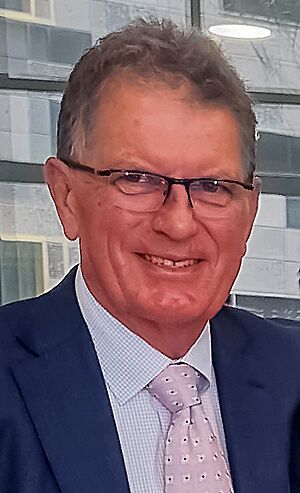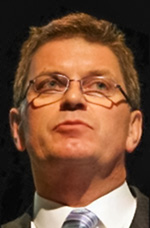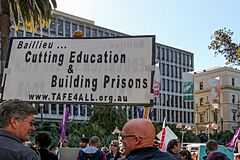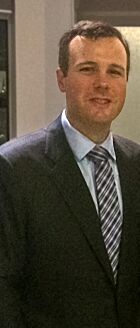Ted Baillieu facts for kids
Quick facts for kids
Ted Baillieu
|
|
|---|---|

Baillieu in 2024
|
|
| 46th Premier of Victoria | |
| In office 2 December 2010 – 6 March 2013 |
|
| Monarch | Elizabeth II |
| Governor | David de Kretser Alex Chernov |
| Deputy | Peter Ryan |
| Preceded by | John Brumby |
| Succeeded by | Denis Napthine |
| Leader of the Opposition in Victoria Elections: 2006 |
|
| In office 8 May 2006 – 2 December 2010 |
|
| Premier | Steve Bracks John Brumby |
| Deputy | Louise Asher |
| Preceded by | Robert Doyle |
| Succeeded by | Daniel Andrews |
| Leader of the Liberal Party in Victoria | |
| In office 8 May 2006 – 6 March 2013 |
|
| Deputy | Louise Asher |
| Preceded by | Robert Doyle |
| Succeeded by | Denis Napthine |
| Member of the Victorian Parliament for Hawthorn |
|
| In office 18 September 1999 – 29 November 2014 |
|
| Preceded by | Phil Gude |
| Succeeded by | John Pesutto |
| Personal details | |
| Born |
Edward Norman Baillieu
31 July 1953 Melbourne, Victoria, Australia |
| Political party | Liberal (since 1981) |
| Spouse | Robyn Jubb |
| Children | 3 |
| Alma mater | University of Melbourne |
| Profession | Architect |
| Signature |  |
Edward Norman Baillieu (born 31 July 1953), known as Ted Baillieu, is a former Australian politician. He served as the Premier of Victoria from 2010 to 2013. A premier is the leader of a state government in Australia.
Baillieu was a member of the Liberal Party and represented the area of Hawthorn in the Victorian Legislative Assembly from 1999 to 2014. He became the leader of his party in 2006. He won the 2010 state election and became premier. He stepped down as premier on 6 March 2013.
Contents
Early Life and Education
Ted Baillieu was born in Melbourne, Victoria. He grew up in the suburb of Toorak. His family has a long history in Victoria, with some relatives also being involved in politics and sports.
He went to Melbourne Grammar School and later studied at the University of Melbourne. In 1976, he earned a degree in architecture, which is the art and science of designing buildings.
Before he became a politician, Baillieu worked as an architect. He also worked for his family's real estate company and for Tourism Victoria, an organization that promotes tourism in the state.
Start in Politics
Baillieu joined the Carlton branch of the Liberal Party in 1981. He became more involved over the years and was the president of the Victorian Liberal Party by 1994.
In 1999, he was encouraged to run for a seat in the Victorian Parliament. He won the election for the district of Hawthorn. After being elected, he was immediately given important roles in the opposition party. The opposition is the main party that is not in power. He served as a "shadow minister," which means he was in charge of watching over government decisions in areas like education and planning.
Becoming Leader of the Liberal Party
In May 2006, the leader of the Liberal Party, Robert Doyle, resigned. Ted Baillieu announced he would run for the leadership position and won without any opposition. This made him the Leader of the Opposition in Victoria.
Six months later, he led his party in the 2006 state election. The Liberal Party did not win the election, but they did gain some seats in parliament.
In 2008, Baillieu helped form a Coalition between the Liberal Party and the Victorian Nationals. A coalition is when two or more political parties agree to work together. This partnership was an important step for the parties to try and win the next election.
Premier of Victoria
In the 2010 Victorian state election, Ted Baillieu ran against the current premier, John Brumby. Baillieu's campaign focused on issues like health, safety, and managing government money. The election was very close.
The Liberal-National Coalition won just enough seats to form a government. They won 45 seats, while the Labor Party won 43. On 2 December 2010, Ted Baillieu was sworn in as the 46th Premier of Victoria.
As premier, his government faced some challenges. Some people felt his government was too slow to make decisions. There were also disagreements over funding for education and environmental policies.
Working with Other Countries
In September 2012, Premier Baillieu led a large group of business leaders on a trip to China. It was the biggest international trade mission from Australia at the time. Over 400 people went to help build stronger business connections between Victoria and China.
Resignation as Premier
On 6 March 2013, Ted Baillieu resigned as Premier of Victoria. This happened after some private conversations involving his staff were made public, causing problems for his government. Another member of his party, Geoff Shaw, also decided to leave the party, which put the government's small majority at risk.
After a meeting with other Liberal Party members, Baillieu stepped down. He was replaced as premier by Denis Napthine. Baillieu continued to serve as a member of parliament for Hawthorn until he retired from politics in 2014.
Life After Politics
After retiring from politics, Ted Baillieu has stayed active in public life. He has been involved in many community and cultural organizations.
Since 2013, he has led the Victorian Government's ANZAC Centenary Committee. This group organizes events to remember the Australian and New Zealand soldiers who served in World War I.
He has also received awards for his work in strengthening relationships between Australia and India. In 2016, he became an Honorary Enterprise Professor at the University of Melbourne in the architecture department. He was also appointed to the committee of the famous Melbourne Cricket Club in 2017.
In June 2021, the Australian Government appointed him as the Chair of the Australian Heritage Council, which helps protect important historical and natural places.
Personal Life
Ted Baillieu is married to his wife, Robyn, and they have three children. One of his sons, Rob Baillieu, was elected to the Boroondara City Council in 2024.
Baillieu is a big supporter of the Geelong Football Club. He is also a keen swimmer and often takes part in open-water swimming events. He is a member of many clubs, including the Melbourne Cricket Club and the Rotary Club of Glenferrie.





